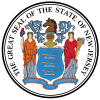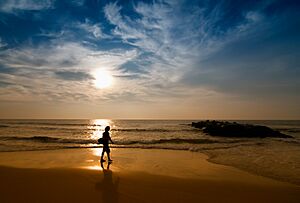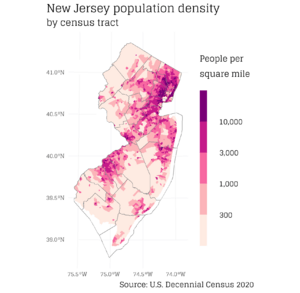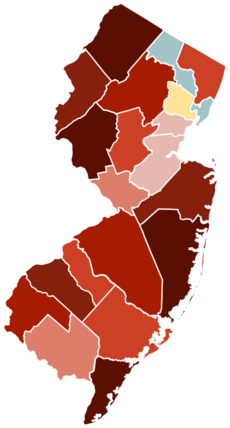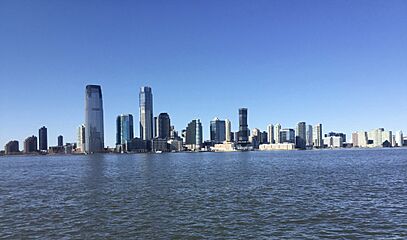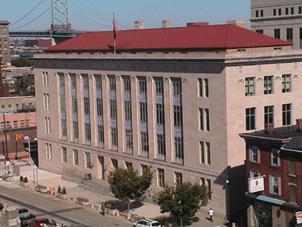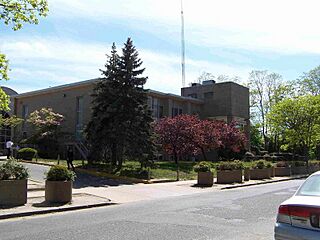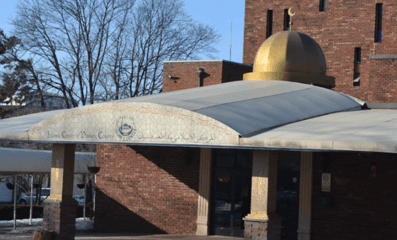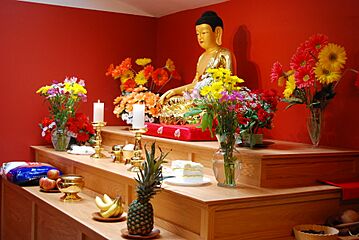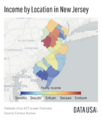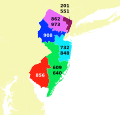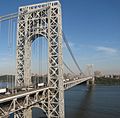New Jersey facts for kids
Quick facts for kids
New Jersey
|
|||
|---|---|---|---|
|
|||
| Nickname(s):
The Garden State
|
|||
| Motto(s):
Liberty and prosperity
|
|||
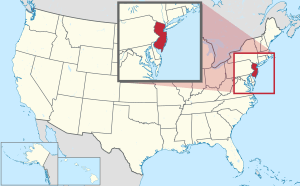
Location of New Jersey within the United States
|
|||
| Country | United States | ||
| Before statehood | Province of New Jersey | ||
| Admitted to the Union | December 18, 1787 (3rd) | ||
| Capital | Trenton | ||
| Largest city | Newark | ||
| Largest county or equivalent | Bergen | ||
| Largest metro and urban areas | New York | ||
| Legislature | New Jersey Legislature | ||
| • Upper house | Senate | ||
| • Lower house | General Assembly | ||
| Judiciary | Supreme Court of New Jersey | ||
| U.S. senators | Cory Booker (D) Andy Kim (D) |
||
| U.S. House delegation | 9 Democrats 3 Republicans (list) |
||
| Area | |||
| • Total | 8,722.58 sq mi (22,591.38 km2) | ||
| • Land | 7,354.22 sq mi (19,047.34 km2) | ||
| • Water | 1,368.36 sq mi (3,544.04 km2) 15.7% | ||
| Area rank | 47th | ||
| Dimensions | |||
| • Length | 170 mi (273 km) | ||
| • Width | 70 mi (112 km) | ||
| Elevation | 250 ft (80 m) | ||
| Highest elevation | 1,803 ft (549.6 m) | ||
| Lowest elevation
(Atlantic Ocean)
|
0 ft (0 m) | ||
| Population
(2024)
|
|||
| • Total | |||
| • Rank | 11th | ||
| • Density | 1,291.9/sq mi (498.8/km2) | ||
| • Density rank | 1st | ||
| • Median household income | $99,800 (2023) | ||
| • Income rank | 3rd | ||
| Demonym(s) | New Jerseyan (official), New Jerseyite | ||
| Language | |||
| • Official language | None | ||
| • Spoken language | |||
| Time zone | UTC−05:00 (Eastern) | ||
| • Summer (DST) | UTC−04:00 (EDT) | ||
| USPS abbreviation |
NJ
|
||
| ISO 3166 code | US-NJ | ||
| Traditional abbreviation | N.J. | ||
| Latitude | 38°56′ N to 41°21′ N | ||
| Longitude | 73°54′ W to 75°34′ W | ||
New Jersey, nicknamed "The Garden State," is a state located in the Mid-Atlantic region of the United States. It is bordered on its north and east by New York state; on its east, southeast, and south by the Atlantic Ocean; on its west by the Delaware River and Pennsylvania; and on its southwest by Delaware Bay and Delaware.
The state capital is Trenton, and the state's most populous city is Newark.
Contents
History
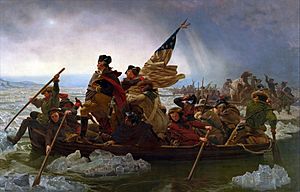
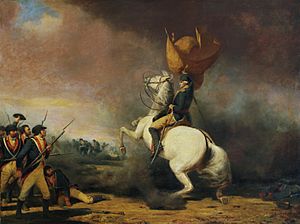
New Jersey was first inhabited by Paleo-Indians as early as 13,000 B.C.E., with the Lenape being the dominant Indigenous group when Europeans arrived in the early 17th century. Dutch and Swedish colonists founded the first European settlements in the state, with the British later seizing control of the region and establishing the Province of New Jersey, named after the largest of the Channel Islands. The colony's fertile lands and relative religious tolerance drew a large and diverse population. New Jersey was among the Thirteen Colonies that supported the American Revolution, hosting several pivotal battles and military commands in the American Revolutionary War. On December 18, 1787, New Jersey became the third state to ratify the United States Constitution, which granted it admission to the Union, and it was the first state to ratify the U.S. Bill of Rights on November 20, 1789.
New Jersey remained in the Union during the American Civil War and provided troops, resources, and military leaders in support of the Union Army. After the war, the state emerged as a major manufacturing center and a leading destination for immigrants, helping drive the Industrial Revolution in the U.S. New Jersey was the site of many industrial, technological, and commercial innovations, including the first town (Roselle) to be illuminated by electricity, the first incandescent light bulb, and the first steam locomotive. Many prominent Americans associated with New Jersey have proven influential nationally and globally, including in academia, advocacy, business, entertainment, government, military, non-profit leadership, and other fields.
New Jersey's central location in the Northeast megalopolis helped fuel its rapid growth and suburbanization in the second half of the 20th century. Since the beginning of the 21st century, the state's economy has become highly diversified, with major sectors including biotechnology, pharmaceuticals, information technology, finance, and tourism.
Geography
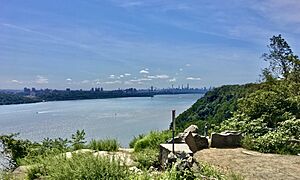
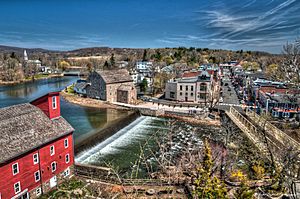
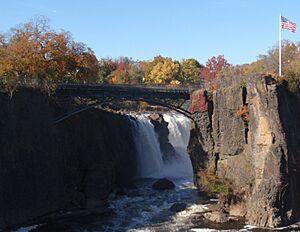
New Jersey is located at the center of the Northeast megalopolis, the most populated American urban agglomeration. It is bordered on the north and northeast by New York (parts of which are across the Hudson River, Upper New York Bay, the Kill Van Kull, Newark Bay, and the Arthur Kill); on the east by the Atlantic Ocean; on the southwest by Delaware across Delaware Bay; and on the west by Pennsylvania across the Delaware River.
New Jersey is broadly divided into the North, Central, and South Jersey geographic regions, although some residents do not consider Central Jersey a region in its own right. Across the regions are five distinct areas divided by natural geography and population concentration. Northeastern New Jersey, often referred to as the Gateway Region, lies closest to Manhattan in New York City, and up to a million residents commute daily into the city for work, many via public transportation. The Jersey Shore, along the Atlantic Coast in Central and South Jersey, has its own unique natural, residential, and cultural characteristics owing to its location by the ocean. South Jersey represents the southernmost geographical region of the northeastern United States. The Delaware Valley includes the southwestern counties of the state, which reside within the Delaware Valley surrounding Philadelphia.
Despite its heavily urban character and a long history of industrialization, forests cover roughly 45 percent of New Jersey's land area, or approximately 2.1 million acres, ranking 31st among the 50 U.S. states and six territories. Northwestern New Jersey, often referred to as the Skylands Region, is more wooded, rural, and mountainous. The chief tree of the northern forests is the oak. The New Jersey Pine Barrens is situated in the southern interior of New Jersey and covered extensively by mixed pine and oak forest; its population density is lower than most of the state.
High Point in Montague Township, Sussex County is the state's highest elevation at 1,803 feet (550 m) above sea level. The state's highest prominence is Kitty Ann Mountain in Morris County, rising 892 feet (272 m). The Palisades are a line of steep cliffs on the west side of the Hudson River in Bergen and Hudson Counties. Major New Jersey rivers include the Hudson, Delaware, Raritan, Passaic, Hackensack, Rahway, Musconetcong, Mullica, Rancocas, Manasquan, Maurice, and Toms rivers. Due to New Jersey's peninsular geography, both sunrise and sunset are visible over water from different points on the Jersey Shore.
Prominent geographic features

- Meadowlands
- New Jersey Pine Barrens
- Delaware Water Gap
- Great Bay
- Great Swamp National Wildlife Refuge
- Highlands
- Hudson Palisades
- Jersey Shore
- On the shore, New Jersey hosts the highest concentration of oceanside boardwalks in the world.
- Ramapo Mountain
- South Mountain
Climate
The state consists of two climate zones; the southernmost edges of the state have a humid subtropical climate, while the rest has a humid continental climate. New Jersey receives between 2,400 and 2,800 hours of sunshine annually.
Summers are typically hot and humid, with statewide average high temperatures of 82–87 °F (28–31 °C) and lows of 60–69 °F (16–21 °C). Winters are usually cold, with average high temperatures of 34–43 °F (1–6 °C) and lows of 16 to 28 °F (−9 to −2 °C) for most of the state. Spring and autumn may feature wide temperature variations, with lower humidity than summer.
Average annual precipitation ranges from 43 to 51 inches (1,100 to 1,300 mm), spread uniformly throughout the year. Average snowfall per winter season ranges from 10–15 inches (25–38 cm) in the south and near the seacoast, 15–30 inches (38–76 cm) in the northeast and central part of the state, to about 40–50 inches (1.0–1.3 m) in the northwestern highlands. Precipitation falls on an average of 120 days a year, with 25 to 30 thunderstorms, most of which occur during the summer.
During winter and early spring, New Jersey can experience nor'easters, which are capable of causing blizzards or flooding throughout the northeastern United States. Hurricanes and tropical storms, tornadoes, and earthquakes are rare.
Major cities and towns
New Jersey has many interesting cities and towns. Let's look at a few:
- Trenton: This is the state capital. It's located on the Delaware River and has a rich history. The New Jersey State House, where important laws are made, is located here.
- Newark: This is the state's largest city. It's a major transportation hub and has a diverse population. Newark has a vibrant arts and culture scene.
- Jersey City: Located across the Hudson River from New York City, Jersey City offers stunning views of the Manhattan skyline. It's a bustling city with a mix of old and new architecture.
- Atlantic City: This famous coastal city is known for its casinos and boardwalk. It's a popular tourist destination, especially during the summer months.
- Princeton: Home to Princeton University, a prestigious university, Princeton is a charming town with a rich academic history.
|
Largest cities or towns in New Jersey
Source: |
||
|---|---|---|
| Rank | Name | Pop. |
| 1 | Newark | 311,549 |
| 2 | Jersey City | 292,449 |
| 3 | Paterson | 159,732 |
| 4 | Elizabeth | 137,298 |
| 5 | Lakewood Township | 135,158 |
| 6 | Edison | 107,588 |
| 7 | Woodbridge Township | 103,639 |
| 8 | Toms River | 95,438 |
| 9 | Hamilton Township | 92,297 |
| 10 | Clifton | 90,296 |
Economy
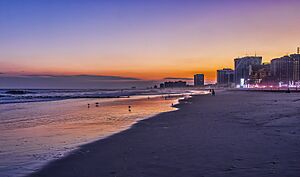
New Jersey has a diverse economy. While agriculture is important, the state also has a strong manufacturing sector, producing a wide range of goods. Pharmaceuticals, chemicals, and food processing are significant industries. Many people also work in finance, technology, and tourism.
The state is also home to many large corporations and businesses. This creates lots of jobs for people who live in New Jersey.
Natural resources and energy
Limited mining activity of zinc, iron, and manganese still takes place in the area in and around the Franklin Furnace in Sussex County.
Although New Jersey is home to many energy-intensive industries, its energy consumption is only 2.7% of the U.S. total, and its carbon dioxide emissions are 0.8% of the U.S. total. New Jersey's electricity comes primarily from natural gas and nuclear power. New Jersey is seventh in the nation in solar power installations, enabled by one of the country's most favorable net metering policies and renewable portfolio standard. The state has more than 140,000 solar installations.
Transportation
New Jersey has a well-developed transportation system. It has a network of highways, making it easy to travel around the state and to neighboring states. New Jersey is connected to New York City via various key bridges and tunnels. The double-decked George Washington Bridge carries the heaviest load of motor vehicle traffic of any bridge in the world, at 102 million vehicles per year, across fourteen lanes.
The state also has a robust public transportation system, including buses and trains. This makes it easier for people to get around without needing a car. The Port of New Jersey is a major port, handling a large volume of goods.
Government
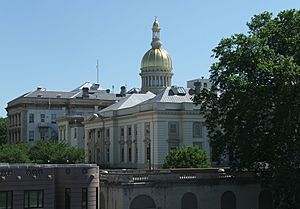
Like all states, New Jersey has its own government. It has a governor, who is the head of the executive branch. The governor's mansion is Drumthwacket, located in Princeton.
The state legislature, made up of the Senate and the General Assembly, makes the laws. New Jersey is one of only five states that elects its state officials in odd-numbered years (the others are Kentucky, Louisiana, Mississippi, and Virginia). New Jersey holds elections for these offices every four years, in the year following each federal Presidential election year.
The judicial branch interprets the laws. The state government works to provide services for its citizens, such as education, healthcare, and public safety.
Administrative divisions
The U.S. Census Bureau divides New Jersey's 21 counties into seven metropolitan statistical areas, with 20 counties included in either the New York City or Philadelphia combined statistical area. Warren County is part of the Pennsylvania-based Lehigh Valley metro area.
Counties
The 21 counties in New Jersey, listed in order by population (as of the 2020 census) are:
- Bergen County: 955,732
- Essex County: 863,728
- Middlesex County: 863,162
- Hudson County: 724,854
- Monmouth County: 643,615
- Ocean County: 637,229
- Union County: 575,345
- Passaic County: 524,118
- Camden County: 523,485
- Morris County: 509,285
- Burlington County: 461,860
- Mercer County: 387,340
- Somerset County: 345,361
- Gloucester County: 302,294
- Atlantic County: 274,534
- Cumberland County: 154,152
- Sussex County: 144,221
- Hunterdon County: 128,947
- Warren County: 109,632
- Cape May County: 95,263
- Salem County: 64,837
Municipalities
For its overall population and nation-leading population density, New Jersey has a relative paucity of classic large cities. This paradox is most pronounced in Bergen County, the state's most populous county, whose 955,732 residents at the 2020 census inhabited 70 municipalities, of which the most populous is Hackensack, with 46,030 residents. Many urban areas extend far beyond the limits of a single large city, as New Jersey municipalities tend to be geographically small; three of the four largest cities in New Jersey by population have under 20 square miles (52 km2) of land area, and eight of the top ten, including all the top five, have a land area under 30 square miles (78 km2). As of the 2010 United States census[update], only four municipalities had over 100,000 residents (although Edison and Woodbridge Township came very close); this number increased to seven by the 2020 census.
Demographics
Residents of New Jersey are most commonly referred to as New Jerseyans or, less commonly, as New Jerseyites. According to the 2020 U.S. census, the state had a population of 9,288,994, a 5.7% increase since the 2010 U.S. census, which counted 8,791,894 residents. The state ranked eleventh in the country by total population and first in population density, with 1,185 residents per square mile (458 per km2).
New Jersey is one of the most ethnically diverse states in the nation: as of 2022, over one-fifth of its residents are Hispanic (21.5%) of its residents are Hispanic or Latino, 15.3% are Black, and one-tenth are Asian.
| Race and Ethnicity | Alone | Total | ||
|---|---|---|---|---|
| White (non-Hispanic) | 51.9% |
|
54.5% |
|
| Hispanic or Latino | — | 21.6% |
|
|
| African American (non-Hispanic) | 12.4% |
|
13.6% |
|
| Asian | 10.2% |
|
11.0% |
|
| Native American | 0.1% |
|
0.7% |
|
| Pacific Islander | 0.02% |
|
0.1% |
|
| Other | 0.8% |
|
1.8% |
|
| Racial composition | 1970 | 1990 | 2000 | 2010 | 2020 |
|---|---|---|---|---|---|
| White | 88.6% | 79.3% | 72.5% | 68.6% | 55.0% |
| Black | 10.7% | 13.4% | 13.6% | 13.7% | 13.1% |
| Asian | 0.3% | 3.5% | 5.7% | 8.3% | 10.2% |
| Native | 0.1% | 0.2% | 0.2% | 0.3% | 0.6% |
| Native Hawaiian and other Pacific Islander |
– | – | – | – | – |
| Other race | 0.3% | 3.6% | 5.4% | 6.4% | 11.3% |
| Two or more races | – | – | 2.5% | 2.7% | 9.7% |
Culture and recreation
| Bird | Eastern goldfinch |
|---|---|
| Fish | Brook trout |
| Flower | Viola sororia |
| Tree | Quercus rubra (northern red oak), dogwood (memorial tree) |
| Insect | Western honey bee |
New Jersey offers a wide range of recreational opportunities. From its beautiful beaches to its state parks and forests, there's something for everyone. Many people enjoy hiking, biking, fishing, and boating.
The state also has a vibrant arts and culture scene, with numerous museums, theaters, and music venues. There are many festivals and events throughout the year, celebrating the state's diverse heritage.
Cuisine
New Jersey is known for several foods developed within the region, including Taylor Ham (also known as pork roll), sloppy joe sandwiches, tomato pies, salt water taffy, and Texas wieners. Just as New York City's cuisine has an influence on North Jersey, Philadelphia's cuisine influences South Jersey.
New Jersey third-largest industry is food and agriculture just behind pharmaceuticals and tourism. New Jersey is one of the top 10 producers of blueberries, cranberries, peaches, tomatoes, bell peppers, eggplant, cucumbers, apples, spinach, squash, and asparagus in the United States. Many restaurants in the state offer locally grown ingredients because of this.
Campbell's Soup Company has been headquartered in Camden since 1869. Goya Foods, the largest Hispanic-owned food company in the United States, operates a corporate headquarters in Jersey City. Mars Wrigley Confectionery's US headquarters has been based in Hackettstown and Newark since 2007.
Several states with substantial Italian American populations take credit for the development of submarine sandwiches, including New Jersey.
Points of interest
Boardwalks
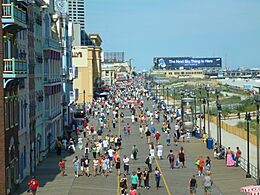
New Jersey is home to the world's highest concentration of boardwalks. Many communities along the Jersey Shore having a boardwalk with various attractions, entertainment, shopping, dining, arcades, water parks, and amusement parks. The Atlantic City boardwalk, opened in 1870, as the world's first boardwalk. At 5+1⁄2 miles (8.9 km) long, it is also the world's longest and busiest boardwalk.
| Venue | Amusement Park | Location | Year opened |
|---|---|---|---|
| Asbury Park Boardwalk | Asbury Splash Park | Asbury Park | 1871 |
| Atlantic City Boardwalk | Steel Pier | Atlantic City | 1870 |
| Jenkinson's Boardwalk | None | Point Pleasant Beach | 1928 |
| Ocean City Boardwalk | Gillian's Wonderland Pier, Playland's Castaway Cove | Ocean City | 1929 |
| Pier Village | None | Long Branch | 2005 |
| Seaside Heights Boardwalk | Casino Pier | Seaside Heights | 1932 |
| Wildwood Boardwalk | Morey's Piers | The Wildwoods | 1969 |
Museums
| Museum | Location | Year opened | Type |
|---|---|---|---|
| New Jersey State Museum | Trenton | 1895 | General education |
| Franklin Mineral Museum | Franklin, Sussex County | 1964 | Mineral museum |
| Liberty Science Center | Liberty State Park, Jersey City | 1993 | Science museum |
| Maywood Station Museum | Maywood | 2004 | Railroad museum |
| Montclair Art Museum | Montclair | 1914 | Art museum |
| Newark Museum | Newark | 1909 | Natural science and art museum |
| Princeton University Art Museum | Princeton | 1884 | Art museum |
| Thomas Edison Center | Menlo Park | 1938 | Thomas Edison museum |
National Park Service areas
- Appalachian National Scenic Trail
- Crossroads of the American Revolution
- Delaware Water Gap National Recreation Area
- Gateway National Recreation Area
- Great Egg Harbor National Scenic and Recreational River
- Morristown National Historical Park
- New Jersey Pinelands National Reserve
- Patterson Great Falls National Historical Park
- Statue of Liberty National Monument (with Ellis Island)
- Thomas Edison National Historical Park
- Washington-Rochambeau Revolutionary Route
Entertainment and concert venues
Visitors and residents take advantage of and contribute to performances at the numerous music, theater, and dance companies and venues located throughout the state, including:
| Venue | Type | Location | Year opened |
|---|---|---|---|
| Prudential Center | Arena | Newark | 2007 |
| New Brunswick Performing Arts Center | Regional Theater | New Brunswick | 2019 |
| PNC Bank Arts Center | Amphitheater | Holmdel | 1977 |
| New Jersey Performing Arts Center | Concert Hall | Newark | 1997 |
| Paper Mill Playhouse | Regional Theater | Millburn | 1968 |
| State Theater | Regional Theater | New Brunswick | 1921 |
| Boardwalk Hall | Arena | Atlantic City | 1926 |
| Freedom Mortgage Pavilion | Amphitheater | Camden | 1995 |
| CURE Insurance Arena | Arena | Trenton | 1999 |
Theme parks
| Main park | Other parks | Location | Year opened |
|---|---|---|---|
| Clementon Amusement Park | Splash World | Clementon | 1907 |
| Diggerland | West Berlin | 2014 | |
| DreamWorks Waterpark | East Rutherford | 2020 | |
| Fantasy Island | Thundering Surf Water Park | Beach Haven | 1985 |
| The Funplex (Mount Laurel) | The Funplex (East Hanover) | Mount Laurel | |
| iPlay America | Freehold | 2011 | |
| Keansburg Amusement Park | Runaway Rapids | Keansburg | 1904 |
| Land of Make Believe | Pirate's Cove | Hope | 1954 |
| Mountain Creek Waterpark | Vernon | 1998 | |
| Nickelodeon Universe | East Rutherford | 2019 | |
| Six Flags Great Adventure | Six Flags Hurricane Harbor | Jackson | 1974 |
| Storybook Land | Egg Harbor Township | 1955 | |
| Wild West City | Stanhope | 1957 |
Stadiums and arenas
| Venue | City | Capacity | Type | Tenants | Opened |
|---|---|---|---|---|---|
| SHI Stadium | Piscataway | 52,454 | Stadium | Rutgers Scarlet Knights | 1994 |
| Jadwin Gymnasium | Princeton | 6,854 | Arena | Princeton Tigers | 1969 |
| Rutgers Athletic Center | Piscataway | 8,000 | Arena | Rutgers Scarlet Knights | 1977 |
| MetLife Stadium | East Rutherford | 82,500 | Stadium | New York Giants, New York Jets | 2010 |
| Princeton Stadium | Princeton | 27,800 | Stadium | Princeton Tigers | 1998 |
| Prudential Center | Newark | 18,711 | Arena | New Jersey Devils, Seton Hall Pirates | 2007 |
| Red Bull Arena | Harrison | 25,189 | Stadium | New York Red Bulls | 2010 |
Other notable sports venues
- Old Bridge Township Raceway Park
- Trenton Speedway
- Atlantic City Race Course
- Freehold Raceway
- Garden State Park Racetrack
- Monmouth Park Racetrack
- Meadowlands Sports Complex
- Meadowlands Arena
- Meadowlands Racetrack
- Meadowlands Grand Prix
-
High-rise residential complexes in the borough of Fort Lee
-
Paterson, sometimes known as Silk City, has become a prime destination for an internationally diverse pool of immigrants, with at least 52 distinct ethnic groups.
-
Skyscrapers in Jersey City, one of the most ethnically diverse cities in the world
-
Federal Courthouse in Camden, which is connected to Philadelphia via the Benjamin Franklin Bridge in the background
-
Cathedral Basilica of the Sacred Heart in Newark, the fifth-largest cathedral in North America, is the seat of the city's Roman Catholic Archdiocese.
-
Beth Medrash Govoha (Hebrew: בית מדרש גבוה), in Lakewood, Ocean County, the world's largest Jewish yeshiva outside Israel. New Jersey is home to the second-highest Jewish American population per capita, after New York, and the fastest-growing Orthodox Jewish population.
-
Swaminarayan Akshardham in Robbinsville, Mercer County, the world's largest Hindu temple outside Asia. New Jersey is home to the highest concentration of Hindus (3%) in the U.S.
-
Islamic Center of Passaic County, Paterson, Passaic County, was founded in 1990. New Jersey is home to one of the highest Muslim population concentrations in the Western hemisphere (3.5%), and Paterson, which houses the Islamic Center of Passaic County, is the epicenter of New Jersey's Muslim community, leading South Paterson to be nicknamed Little Istanbul and Little Ramallah.
-
So Shim Sa Zen Center in Middlesex County, serving New Jersey's growing Buddhist community
Interesting facts about New Jersey
- New Jersey is the fifth-smallest state in land area.
- It is one of the most educated, affluent, healthy, diverse and highly developed states in the U.S.
- New Jersey has more scientists and engineers per square mile than anywhere in the world.
- It has the highest representation of millionaires among all states.
- In 2024, New Jersey was ranked as having the second-healthiest population overall.
- Diners are iconic to New Jersey. The state is home to many diner manufacturers and has over 600 diners, more than any other place in the world.
- It is the only state to have never had a state song; as of 2021, it is one of only two states (the other being Maryland) that are currently without a state song.
- New Jersey is the birthplace of many modern inventions, including FM radio, the motion picture camera, the lithium battery, the light bulb, transistors, and the electric train. Other New Jersey creations include: the drive-in movie, the cultivated blueberry, cranberry sauce, the boardwalk, the zipper, the phonograph, saltwater taffy, the dirigible, the seedless watermelon, the first use of a submarine in warfare, and the ice cream cone.
Images for kids
-
A map of New Netherland and New Sweden in New Jersey during the colonial era
-
Map of the 107-mile-long (172 km) Morris Canal across North Jersey
-
India Square in the Marion Section of Jersey City is home to the highest concentration of Asian Indians in the Western Hemisphere.
-
Koreatown, Bergen County, across the George Washington Bridge from New York City
-
Metropolitan statistical areas and divisions of New Jersey; those shaded in blue are part of the New York City Metropolitan Area, including Mercer and Warren counties. Counties shaded in green, including Atlantic, Cape May, and Cumberland counties, belong to the Philadelphia Metropolitan Area.
-
Cranberry harvest
-
New Jersey's telephone area codes
-
The Downtown Jersey City waterfront skyline is dubbed Wall Street West.
-
Old Queens at Rutgers University, the largest state university system in New Jersey
-
Nassau Hall at Princeton University, an Ivy League university and one of the world's most prominent research institutions, served briefly as the U.S. Capitol in the 18th century.
-
The George Washington Bridge, connecting Fort Lee (foreground) in Bergen County across the Hudson River to New York City (background), is the world's busiest motor vehicle bridge.
-
A NJ Transit train on the Northeast Corridor in Rahway
-
Two Hudson–Bergen Light Rail trains in Jersey City
-
Cape May–Lewes Ferry connects New Jersey and Delaware across Delaware Bay.
-
New Brunswick, nicknamed the Hub city and the Healthcare City, is a focus city for academia, healthcare, and culture in New Jersey.
-
MetLife Stadium in East Rutherford, one of only two NFL stadiums shared by two teams, is home to the New York Giants and New York Jets.
-
Prudential Center in Newark, home of the NHL's New Jersey Devils
See also
 In Spanish: Nueva Jersey para niños
In Spanish: Nueva Jersey para niños



